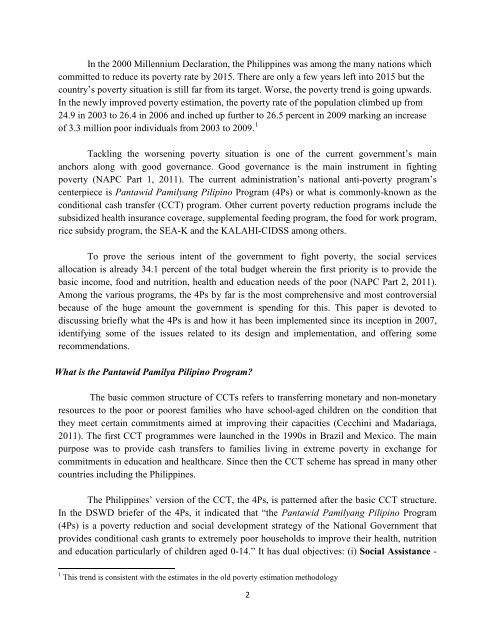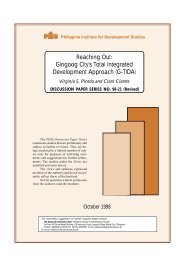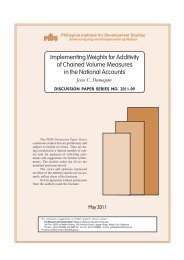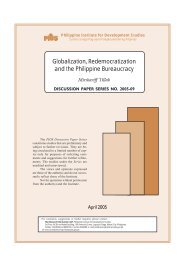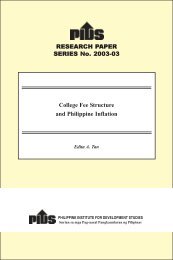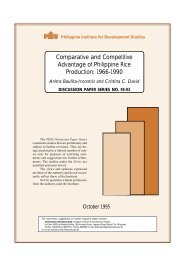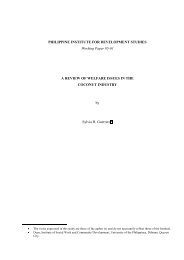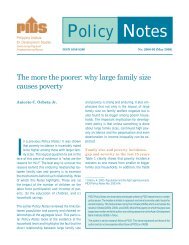Conditional Cash Transfer Program in the Philippines: Is It Reaching ...
Conditional Cash Transfer Program in the Philippines: Is It Reaching ...
Conditional Cash Transfer Program in the Philippines: Is It Reaching ...
Create successful ePaper yourself
Turn your PDF publications into a flip-book with our unique Google optimized e-Paper software.
In <strong>the</strong> 2000 Millennium Declaration, <strong>the</strong> Philipp<strong>in</strong>es was among <strong>the</strong> many nations whichcommitted to reduce its poverty rate by 2015. There are only a few years left <strong>in</strong>to 2015 but <strong>the</strong>country’s poverty situation is still far from its target. Worse, <strong>the</strong> poverty trend is go<strong>in</strong>g upwards.In <strong>the</strong> newly improved poverty estimation, <strong>the</strong> poverty rate of <strong>the</strong> population climbed up from24.9 <strong>in</strong> 2003 to 26.4 <strong>in</strong> 2006 and <strong>in</strong>ched up fur<strong>the</strong>r to 26.5 percent <strong>in</strong> 2009 mark<strong>in</strong>g an <strong>in</strong>creaseof 3.3 million poor <strong>in</strong>dividuals from 2003 to 2009. 1Tackl<strong>in</strong>g <strong>the</strong> worsen<strong>in</strong>g poverty situation is one of <strong>the</strong> current government’s ma<strong>in</strong>anchors along with good governance. Good governance is <strong>the</strong> ma<strong>in</strong> <strong>in</strong>strument <strong>in</strong> fight<strong>in</strong>gpoverty (NAPC Part 1, 2011). The current adm<strong>in</strong>istration’s national anti-poverty program’scenterpiece is Pantawid Pamilyang Pilip<strong>in</strong>o <strong>Program</strong> (4Ps) or what is commonly-known as <strong>the</strong>conditional cash transfer (CCT) program. O<strong>the</strong>r current poverty reduction programs <strong>in</strong>clude <strong>the</strong>subsidized health <strong>in</strong>surance coverage, supplemental feed<strong>in</strong>g program, <strong>the</strong> food for work program,rice subsidy program, <strong>the</strong> SEA-K and <strong>the</strong> KALAHI-CIDSS among o<strong>the</strong>rs.To prove <strong>the</strong> serious <strong>in</strong>tent of <strong>the</strong> government to fight poverty, <strong>the</strong> social servicesallocation is already 34.1 percent of <strong>the</strong> total budget where<strong>in</strong> <strong>the</strong> first priority is to provide <strong>the</strong>basic <strong>in</strong>come, food and nutrition, health and education needs of <strong>the</strong> poor (NAPC Part 2, 2011).Among <strong>the</strong> various programs, <strong>the</strong> 4Ps by far is <strong>the</strong> most comprehensive and most controversialbecause of <strong>the</strong> huge amount <strong>the</strong> government is spend<strong>in</strong>g for this. This paper is devoted todiscuss<strong>in</strong>g briefly what <strong>the</strong> 4Ps is and how it has been implemented s<strong>in</strong>ce its <strong>in</strong>ception <strong>in</strong> 2007,identify<strong>in</strong>g some of <strong>the</strong> issues related to its design and implementation, and offer<strong>in</strong>g somerecommendations.What is <strong>the</strong> Pantawid Pamilya Pilip<strong>in</strong>o <strong>Program</strong>?The basic common structure of CCTs refers to transferr<strong>in</strong>g monetary and non-monetaryresources to <strong>the</strong> poor or poorest families who have school-aged children on <strong>the</strong> condition that<strong>the</strong>y meet certa<strong>in</strong> commitments aimed at improv<strong>in</strong>g <strong>the</strong>ir capacities (Cecch<strong>in</strong>i and Madariaga,2011). The first CCT programmes were launched <strong>in</strong> <strong>the</strong> 1990s <strong>in</strong> Brazil and Mexico. The ma<strong>in</strong>purpose was to provide cash transfers to families liv<strong>in</strong>g <strong>in</strong> extreme poverty <strong>in</strong> exchange forcommitments <strong>in</strong> education and healthcare. S<strong>in</strong>ce <strong>the</strong>n <strong>the</strong> CCT scheme has spread <strong>in</strong> many o<strong>the</strong>rcountries <strong>in</strong>clud<strong>in</strong>g <strong>the</strong> Philipp<strong>in</strong>es.The Philipp<strong>in</strong>es’ version of <strong>the</strong> CCT, <strong>the</strong> 4Ps, is patterned after <strong>the</strong> basic CCT structure.In <strong>the</strong> DSWD briefer of <strong>the</strong> 4Ps, it <strong>in</strong>dicated that “<strong>the</strong> Pantawid Pamilyang Pilip<strong>in</strong>o <strong>Program</strong>(4Ps) is a poverty reduction and social development strategy of <strong>the</strong> National Government thatprovides conditional cash grants to extremely poor households to improve <strong>the</strong>ir health, nutritionand education particularly of children aged 0-14.” <strong>It</strong> has dual objectives: (i) Social Assistance -1 This trend is consistent with <strong>the</strong> estimates <strong>in</strong> <strong>the</strong> old poverty estimation methodology2


